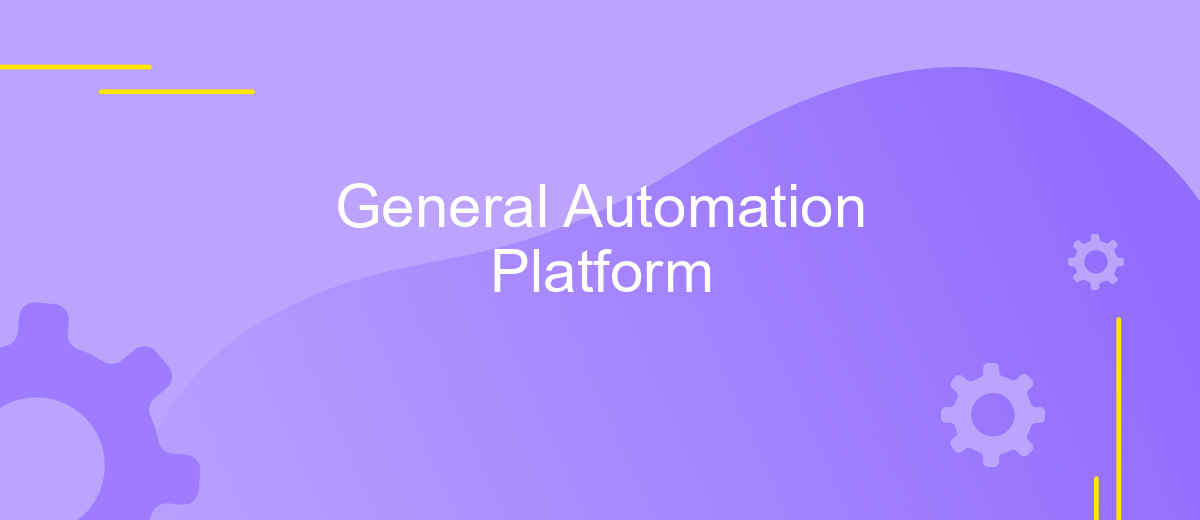General Automation Platform
In today's fast-paced digital landscape, businesses are increasingly turning to automation to streamline operations and enhance productivity. A General Automation Platform serves as a versatile solution, enabling organizations to automate repetitive tasks, integrate diverse systems, and optimize workflows. By leveraging cutting-edge technology, these platforms empower businesses to reduce operational costs, minimize human error, and focus on strategic growth, making them indispensable in the modern enterprise environment.
Introduction
The evolution of technology has ushered in a new era of efficiency and productivity, largely driven by automation. General Automation Platforms (GAPs) have emerged as pivotal tools in this transformation, offering businesses the ability to streamline processes, reduce errors, and enhance performance across various sectors. These platforms are designed to integrate seamlessly into existing systems, providing a comprehensive solution that caters to diverse operational needs.
- Seamless integration with existing IT infrastructure
- Enhanced scalability and flexibility for growing businesses
- Reduction in operational costs and human errors
- Improved data accuracy and decision-making capabilities
- Customization options to meet specific industry requirements
As industries continue to embrace digital transformation, the role of General Automation Platforms becomes increasingly significant. They not only facilitate the automation of repetitive tasks but also empower organizations to focus on innovation and strategic growth. By leveraging the capabilities of GAPs, companies can achieve a competitive edge, ensuring sustainable success in an ever-evolving marketplace. The adoption of these platforms represents a strategic investment in the future, driving both efficiency and innovation.
Architecture

The architecture of a General Automation Platform is designed to provide seamless integration and streamlined workflows across various applications and services. At its core, the platform utilizes a modular approach, enabling users to customize and scale their automation processes according to specific needs. This flexibility is achieved through a combination of APIs, connectors, and pre-built templates, which facilitate the integration of diverse systems without requiring extensive coding knowledge.
One of the key components in this architecture is the integration layer, which acts as a bridge between disparate systems. Services like ApiX-Drive play a crucial role in this layer by offering user-friendly tools to set up and manage integrations effortlessly. ApiX-Drive simplifies the process of connecting different applications, allowing users to automate data transfer and synchronization efficiently. This not only enhances operational efficiency but also reduces the risk of errors, ensuring that the platform delivers consistent and reliable performance across all integrated systems.
Benefits and Use Cases

The General Automation Platform (GAP) offers transformative benefits for businesses looking to enhance efficiency and streamline operations. By integrating various processes into a unified system, GAP reduces manual intervention, minimizes errors, and accelerates task completion. This not only leads to cost savings but also allows employees to focus on more strategic activities, fostering innovation and growth.
- Process Optimization: Automate repetitive tasks to improve accuracy and speed.
- Scalability: Easily adapt to increased workloads without compromising performance.
- Data Integration: Seamlessly connect disparate systems for comprehensive data analysis.
- Enhanced Collaboration: Facilitate communication and coordination across departments.
- Cost Efficiency: Reduce operational costs through automation and resource optimization.
GAP's versatility makes it suitable for various industries, including manufacturing, healthcare, finance, and retail. In manufacturing, it can automate supply chain management, ensuring timely delivery and inventory control. Healthcare providers can use GAP to manage patient records and streamline appointment scheduling. Financial institutions benefit from automated compliance checks and transaction processing, while retailers can enhance customer experiences through personalized marketing and inventory management. As businesses increasingly adopt digital transformation strategies, the role of GAP becomes indispensable in achieving operational excellence and competitive advantage.
Implementation and Best Practices

Implementing a General Automation Platform requires a strategic approach to ensure seamless integration and optimal performance. Start by assessing your current processes and identifying areas that would benefit most from automation. This evaluation will guide the selection of features and tools necessary for your platform.
Next, prioritize scalability and flexibility in your platform design. This ensures that as your business grows, the platform can adapt without significant overhauls. Engage stakeholders from various departments to gather diverse insights, which can help in customizing the platform to meet specific needs.
- Conduct thorough testing to identify potential issues before full deployment.
- Provide comprehensive training for staff to maximize the platform's capabilities.
- Establish clear metrics to evaluate the platform's impact on productivity and efficiency.
- Maintain regular updates and reviews to keep the platform aligned with business goals.
Finally, foster a culture of continuous improvement by encouraging feedback and innovation. This approach not only enhances the platform's effectiveness but also empowers employees to contribute to ongoing optimization efforts. By adhering to these best practices, your organization can fully leverage the potential of a General Automation Platform.


Future Trends and Evolution
The future of General Automation Platforms is poised for significant evolution as businesses increasingly seek to streamline operations and enhance efficiency. One prominent trend is the integration of artificial intelligence and machine learning, which will enable platforms to offer predictive analytics and smarter automation processes. This will allow companies to anticipate needs and automate complex tasks with greater accuracy. Additionally, the rise of no-code and low-code solutions will democratize automation, empowering non-technical users to create and manage automated workflows without extensive programming knowledge.
As the demand for seamless integrations grows, platforms like ApiX-Drive will play a crucial role in connecting disparate systems and applications. ApiX-Drive's ability to facilitate easy and quick integrations without requiring technical expertise will become increasingly valuable. Furthermore, the shift towards cloud-based solutions will enhance scalability and accessibility, allowing businesses to adapt to changing demands rapidly. Overall, General Automation Platforms will continue to evolve, driven by technological advancements and the need for agile, interconnected business solutions.
FAQ
What is a General Automation Platform?
How can a General Automation Platform benefit my business?
What types of tasks can be automated using a General Automation Platform?
Do I need technical skills to use a General Automation Platform?
How do I integrate different applications with a General Automation Platform?
Apix-Drive is a universal tool that will quickly streamline any workflow, freeing you from routine and possible financial losses. Try ApiX-Drive in action and see how useful it is for you personally. In the meantime, when you are setting up connections between systems, think about where you are investing your free time, because now you will have much more of it.

